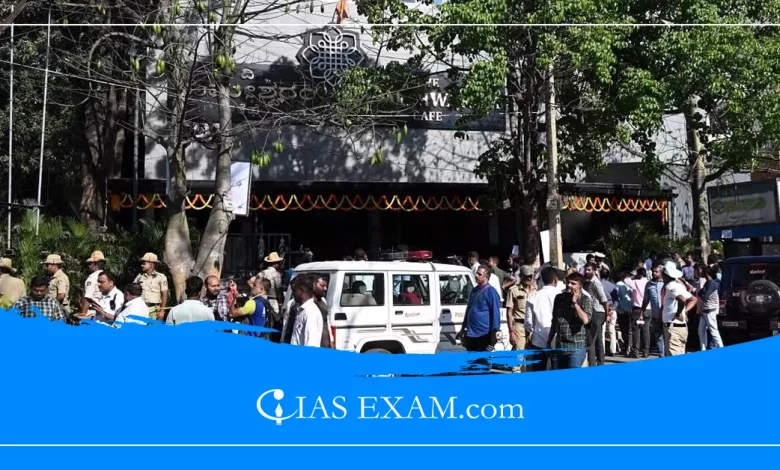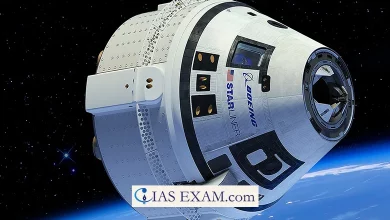Daily Current Affairs for UPSC
Improvised explosive devices(IEDs) – Bengaluru Explosion
Syllabus: Science and technology[GS Paper-3]

Context
- A small explosion caused by a homemade bomb at Rameshwaram Cafe in Whitefield has raised worries about the safety of the people in Bengaluru.
- There have been several notable incidents in the past where improvised explosive devices (IEDs) were utilised, such as the Mumbai serial blasts in 1993, the Jaipur blasts in 2008, the Jama Masjid bombings in 2006, and the Bodh Gaya bombings in 2013.
- Additionally, IEDs have been frequently employed by Maoist insurgents and militants in Kashmir.
Improvised explosive devices(IEDs)
- The term “Improvised Explosive Device” or IED became widely recognized during the United States’ military intervention in Iraq, which began in 2003.
- These homemade bombs were frequently employed against American troops during the conflict.
- Essentially, an IED is a makeshift explosive device created using various materials.
- There is a wide range of IED types, from simple pipe bombs to complex devices designed to inflict significant destruction and casualties.
- They can be utilised in various ways, such as being attached to vehicles, carried by individuals, planted discreetly, or even disguised as ordinary packages.
- Additionally, IEDs are commonly hidden along roadways to target passing military convoys or civilian vehicles.
Different Parts of an IED
- In a common improvised explosive device (IED), the components are usually the same, and they can be of different forms of the one who is making the bomb having different resources.
- These elements are similar yet key to their success, which is why they comprise an initiator (trigger mechanism), a switch (for arming the explosive), a main charge (for the explosion), a power source (since most of the IEDs are electronic, they always require an electronic power source), and a container.
- Besides that, IEDs can be filled with supplements or investigating devices of nails, glass or metal nails that are aimed to increase the amount of the shrapnel dispersed and thus increase the damage produced.
- It is highlighted with GDMAs, that which poses hazardous substances to people like poisonous chemicals or radioactive materials for example, a HED that contains depleted uranium can anonymously be described as a “dirty bomb.”
- For the fabrication of IEDs, a variety of used materials such as ammonium nitrate and urea nitrate, gunpowder and hydrogen peroxide are usually relied on.
- The rationale of the restriction on liquids carried on board of commercial flights is to anticipate the possible risk of potential homemade explosives (IEDs) made by mixing the readily available liquids in those flights.
Disadvantages of IEDs
- IEDs are not only intended in order to bring harm and casualties but also they are quite often employed for diversion purposes, which are particularly common under the conditions of on-going conflicts.
- The degree of the damage caused by an IED depends on a number of factors such as its size, current state, location of the thing, and type of the filler whether it has frame or propellant.
- The nature of IEDs is that the trade-off often involves a lot of hidden repercussions where the smaller ones are easily concealable, transportable, and set off, but they tend to cause less damage than large ones, especially the vehicle triggered ones.
- In addition, IEDs are able not only to be equipped with typical fillings, like nails, glass or metal fragments assembled in such a way to maximise the amount of additional shrapnel at a moment of detonation but also to be strengthened with other explosives or incorporating some other destructive substances.
- Such means also involve the use of radioactive materials or toxic compounds for turning the improvised explosive device into the dirty bomb once loaded with depleted uranium.
- Fertilisers such as ammonium nitrate and urea nitrate, gunpowder, hydrogen peroxide are necessary elements in IEDs construction.
- The prohibition on carrying large quantities of liquids on commercial flights is the result of preventive measures taken to restrict terrorist activities that involve mixing available liquids at airports such as hair sprays and moisturisers.
Conclusion
Usually, IEDs have a trade-off where smaller bombs are easier to conceal and use, but they cause less destruction compared to larger bombs, especially those that are deployed using vehicles.
Source: The Indian Express
UPSC Mains Practice Questions
Q.Give an explanation of IEDs and list the different types of IEDs, along with recent developments, uses, and drawbacks.





.png)



